Among other bits of '80s nostalgia that Stranger Things has brought back into fashion, is the love for synth music. Fortunately, there are bands in the city that will feed your hunger
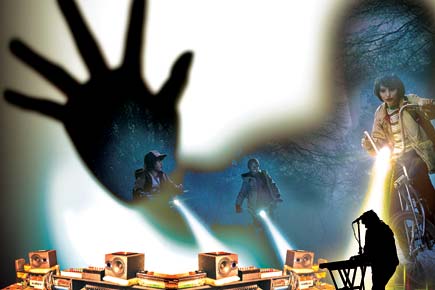
If you are one of the estimated 8.2 million to have watched and loved the Netflix original Stranger Things (since its release on July 15), you've had to have noticed its soundtrack. Music composers Kyle Dixon and Michael Stein, both from Austin, Texas, who play in a synth quartet called Survive, composed the theme and background, and their haunting music instantly took us back to the 80s, when synth music was all the rage.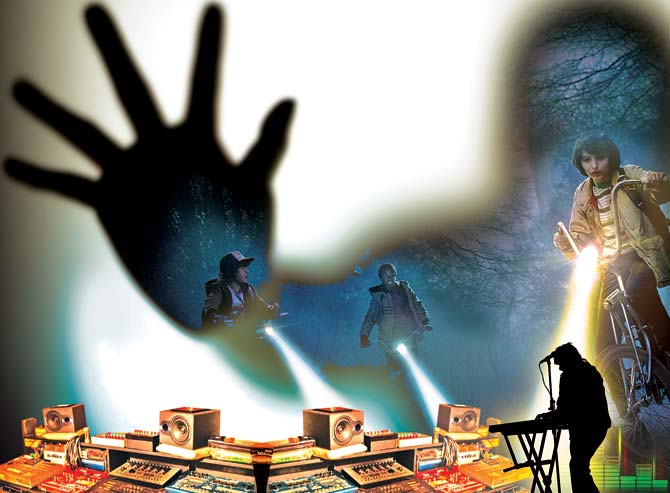
ADVERTISEMENT
Think bands like Depeche Mode, Kraftwerk, Eurythmics, Duran Duran, and the Pet Shop Boys. In the mid-2000s emerged Synthwave, a musical style that was heavily influenced by the 80s, with artistes like Kavinsky (who gave music for the movie Drive), Electric Youth and Power Glove. When we started digging, we realised that Mumbai itself was home to many artistes embracing the synth and using it to give their music that extra something.
What is a synth?
All sounds we hear are made up of individual frequencies. For example, a bass guitar generates a low frequency sound, while a bell emits a high frequency sound. Sounds can also be created by blending individual frequencies in a specific balance. This is the function of a synthesiser. The first person to develop one was American engineer Robert Moog, whose invention was called the Moog synthesiser in the 60s. Musicians began using a synthesiser to create a brand new palate of sounds which led to the dawn of electronic music. The synthesiser generates electric signals that are converted to sound; are often played with a musical keyboard, but they also can be controlled via a variety of other input devices, including music sequencers and instrument controllers. The end result is a new gamut of sounds that are original to the musician creating them.

Sanaya Ardeshir. Pic/Tanya Prasad
"If you just play an instrument, after a few years, you may wonder ‘what to do with this?’ You have juiced it completely. But with the synth, there are hundreds of permutations to try. You can keep using it for decades and won’t run out of sounds," explains 27-year-old Sanaya Ardeshir, also known as Sandunes. A synth player herself, Sanaya’s haunting, down-tempo electronic music is a good example of what synths can do. For example, in her song, Crystal Pink, from her soon to be released album, Downstream (which releases in two months), she uses ethereal sounds to create a landscape that transports you to a dreamy place.
"I got interested in the synth while studying music in the UK. One day, I was in the studio that had all the synths, and once I tried them, my mind just blew. It was such a transition. Even being a pianist, I knew this was the direction I wanted to take, because of what all one can do with it," says the musician, who is planning to buy a new synth to add to her collection. "The challenge is to create music that sounds fresh and different but also resonates with a large majority of people," she smiles. Different types of synths — like the Moog or the Doepfer, for example — use different synthesis technology to produce varied sounds.
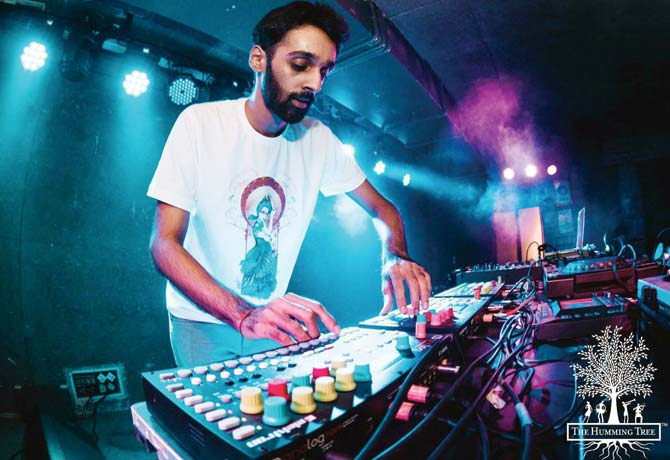
Akshay Rajpurohit
Experimenting is key
Andheri-based band Paraphoniks’ music makes us feel as if we are in Goa, watching the sun go down. "That’s the beauty of it," says Siddhant Shirodkar, 24, "everyone interprets it differently." Shirodkar and 23-year-old Shatrunjai Dewan’s studio is full of big machines that glow and blink. These block-like structures full of knobs are what are known as modular analog synths. "These can be attached to any musical instrument to manipulate the sound according to what you want," explains Jai. The one-year-old band, whose album Yarns will be out in two weeks, sees the synth as an enabler in creating music that’s never been heard before.
"When I first heard [Shatrun]Jai play, I was flabbergasted that someone was actually making this type of music." When on stage, they take along their whole studio set up. Their audience they say is aged between 21 and 30, but they say the acceptance of such kind of music has been encouraging. "Lots of venues want this music. And in India itself, electronic music has taken off in a big way. DJs like Tiesto now play at weddings. So it has opened up avenues," says Jai, adding, "This is pure and simple electronic music. And that works."
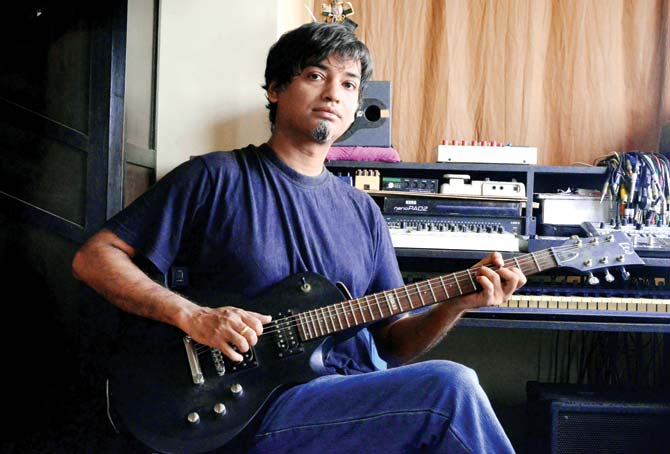
Himanshu Pandey, 39, who plays regularly around Mumbai at clubs like the Den, Anti-Social and Bonobo is currently building his own synth. Pic/Prabhanjan Dhanu
If you are one of the estimated 8.2 million to have watched and loved the Netflix original Stranger Things (since its release on July 15), you've had to have noticed its soundtrack. Music composers Kyle Dixon and Michael Stein, both from Austin, Texas, who play in a synth quartet called Survive, composed the theme and background, and their haunting music instantly took us back to the 80s, when synth music was all the rage.
Think bands like Depeche Mode, Kraftwerk, Eurythmics, Duran Duran, and the Pet Shop Boys. In the mid-2000s emerged Synthwave, a musical style that was heavily influenced by the 80s, with artistes like Kavinsky (who gave music for the movie Drive), Electric Youth and Power Glove. When we started digging, we realised that Mumbai itself was home to many artistes embracing the synth and using it to give their music that extra something.
What is a synth?
All sounds we hear are made up of individual frequencies. For example, a bass guitar generates a low frequency sound, while a bell emits a high frequency sound. Sounds can also be created by blending individual frequencies in a specific balance. This is the function of a synthesiser. The first person to develop one was American engineer Robert Moog, whose invention was called the Moog synthesiser in the 60s. Musicians began using a synthesiser to create a brand new palate of sounds which led to the dawn of electronic music. The synthesiser generates electric signals that are converted to sound; are often played with a musical keyboard, but they also can be controlled via a variety of other input devices, including music sequencers and instrument controllers. The end result is a new gamut of sounds that are original to the musician creating them.
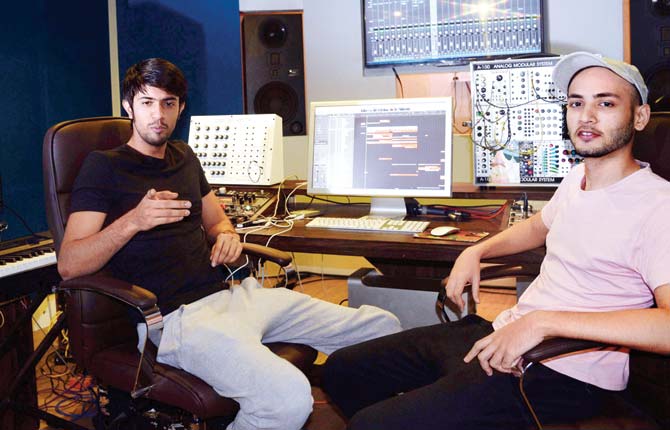
Siddhant Shirodkar and Shatrunjai Dewan form Paraphoniks, whose album Yarns will be out in two weeks. When on stage, they take their whole studio set-up along. Pic/Suresh Karkera
“If you just play an instrument, after a few years, you may wonder ‘what to do with this?’ You have juiced it completely. But with the synth, there are hundreds of permutations to try. You can keep using it for decades and won’t run out of sounds,” explains 27-year-old Sanaya Ardeshir, also known as Sandunes. A synth player herself, Sanaya’s haunting, down-tempo electronic music is a good example of what synths can do. For example, in her song, Crystal Pink, from her soon to be released album, Downstream (which releases in two months), she uses ethereal sounds to create a landscape that transports you to a dreamy place.
“I got interested in the synth while studying music in the UK. One day, I was in the studio that had all the synths, and once I tried them, my mind just blew. It was such a transition. Even being a pianist, I knew this was the direction I wanted to take, because of what all one can do with it,” says the musician, who is planning to buy a new synth to add to her collection. “The challenge is to create music that sounds fresh and different but also resonates with a large majority of people,” she smiles. Different types of synths — like the Moog or the Doepfer, for example — use different synthesis technology to produce varied sounds.
Experimenting is key
Andheri-based band Paraphoniks’ music makes us feel as if we are in Goa, watching the sun go down. “That’s the beauty of it,” says Siddhant Shirodkar, 24, “everyone interprets it differently.” Shirodkar and 23-year-old Shatrunjai Dewan’s studio is full of big machines that glow and blink. These block-like structures full of knobs are what are known as modular analog synths. “These can be attached to any musical instrument to manipulate the sound according to what you want,” explains Jai. The one-year-old band, whose album Yarns will be out in two weeks, sees the synth as an enabler in creating music that’s never been heard before.
“When I first heard [Shatrun]Jai play, I was flabbergasted that someone was actually making this type of music.” When on stage, they take along their whole studio set up. Their audience they say is aged between 21 and 30, but they say the acceptance of such kind of music has been encouraging. “Lots of venues want this music. And in India itself, electronic music has taken off in a big way. DJs like Tiesto now play at weddings. So it has opened up avenues,” says Jai, adding, “This is pure and simple electronic music. And that works.”
Pop culture matters
“Electronic music is not possible without synthesisers, so they’ve always been around and probably will be. The synthwave has been on for quite sometime but people have just taken notice because of movies like Tron and shows like Stranger Things. It makes a lot of trendy kids jump on the bandwagon but popularity could be a double-edged sword,” feels musician Akshay Rajpurohit, 29, who used to be a part of metal band Scribe and then went on to have his own outfit Aqua Dominatrix. As you watch Rajpurohit turn knobs on his synths in his video for his song Tribunal Giulietta, which will have you dancing with its space-agey sounds, you sort of start getting what a synth does.
“Back in 2006, when I was experimenting with sounds for Scribe, I really felt there’s only so much you could do with guitars and wanted to open my palette to new sounds. I started experimenting with synths then, making ambient music and adding sonic textures to our album Confect. I started digging what I could accomplish with them and started working on synth driven music while also using them to add layers to the Pangea album,” he says, and then adds, “As time flew by, I fell deeper into the rabbit hole and started writing music that I really loved with just synthesisers — synthpop/techno which in turn helped me put Aqua Dominatrix into context around 2011.” Rajpurohit is not just intent on making music for the hipster though. You will find covers of popular Bollywood songs on his YouTube, done in synth. Think Woh Kali Kali Ankhein from Darr.
For musician Himanshu Pandey, a synth addict (he has more than 30 of them and has spent his life savings on them), the synth could change the way music is played and perceived. “A few years ago, dub step was a big hit, but people got ear fatigue soon. So the sound has moved to a minimal sound. And that’s where this kind of music comes in,” says the 39-year-old, who is currently building his own synth. “But the music that one plays using these synths should not just be intellectual experiments, that only you end up liking,” says the DJ who plays regularly around Mumbai at clubs like the Den, Anti-Social and Bonobo. “They should be relatable, yet fresh, and that's how this music will catch on.” For now, the synth is getting ready for its big moment. And thanks to shows like Stranger Things, it can’t be far away. The good thing, as Rajpurohit
points out, is the urge to listen to varied music is growing.
“If Bollywood accepts it, then it could have a market,” he laughs, “But right now, people like a lot of different music and I guess the synthwave can sit somewhere in the middle.” "Electronic music is not possible without synthesisers, so they’ve always been around and probably will be. The synthwave has been on for quite sometime but people have just taken notice because of movies like Tron and shows like Stranger Things. It makes a lot of trendy kids jump on the bandwagon but popularity could be a double-edged sword," feels musician Akshay Rajpurohit, 29, who used to be a part of metal band Scribe and then went on to have his own outfit Aqua Dominatrix. As you watch Rajpurohit turn knobs on his synths in his video for his song Tribunal Giulietta, which will have you dancing with its space-agey sounds, you sort of start getting what a synth does.
"Back in 2006, when I was experimenting with sounds for Scribe, I really felt there’s only so much you could do with guitars and wanted to open my palette to new sounds. I started experimenting with synths then, making ambient music and adding sonic textures to our album Confect. I started digging what I could accomplish with them and started working on synth driven music while also using them to add layers to the Pangea album," he says, and then adds, "As time flew by, I fell deeper into the rabbit hole and started writing music that I really loved with just synthesisers — synthpop/techno which in turn helped me put Aqua Dominatrix into context around 2011." Rajpurohit is not just intent on making music for the hipster though. You will find covers of popular Bollywood songs on his YouTube, done in synth. Think Woh Kali Kali Ankhein from Darr.
For musician Himanshu Pandey, a synth addict (he has more than 30 of them and has spent his life savings on them), the synth could change the way music is played and perceived. "A few years ago, dub step was a big hit, but people got ear fatigue soon. So the sound has moved to a minimal sound. And that’s where this kind of music comes in," says the 39-year-old, who is currently building his own synth. "But the music that one plays using these synths should not just be intellectual experiments, that only you end up liking," says the DJ who plays regularly around Mumbai at clubs like the Den, Anti-Social and Bonobo. "They should be relatable, yet fresh, and that's how this music will catch on." For now, the synth is getting ready for its big moment. And thanks to shows like Stranger Things, it can’t be far away. The good thing, as Rajpurohit points out, is the urge to listen to varied music is growing.
"If Bollywood accepts it, then it could have a market," he laughs, "But right now, people like a lot of different music and I guess the synthwave can sit somewhere in the middle."
 Subscribe today by clicking the link and stay updated with the latest news!" Click here!
Subscribe today by clicking the link and stay updated with the latest news!" Click here!







